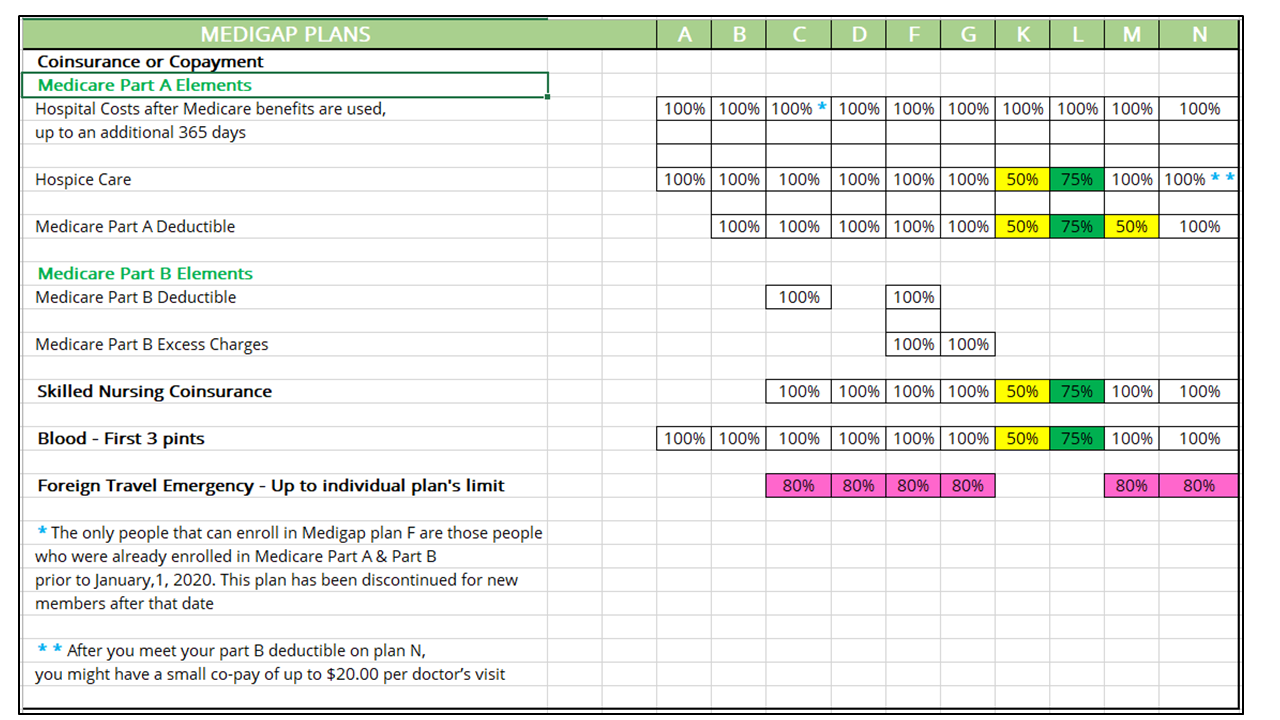Medicare Supplement Plans
Medicare Supplement Plans
Medicare Supplement, also called Medigap, are plans sold by private insurance companies to fill in the coverage gaps and deductibles that Original Medicare does not cover. For instance, if Medicare covers 80 percent of a doctor’s visit, Medigap will cover the remaining 20 percent. With a Medicare Supplemental plan, there is little additional cost to you for healthcare beyond your premium.
Advantages of a standard Medicare Supplement policy are:
- Choose your own doctor and hospitals
- No referrals required
- You can use it anywhere in the United States as long as they accept Medicare
- You know what your expenses are which makes it easier to budget
Additional elements to know about Medicare Supplement insurance:
- You must have Part A and Part B to buy a Medicare Supplement policy
- Many carriers offer household discounts if two or more people enroll in Medicare supplement plans from the same company
- Plans do not include Part D, so you’ll add a separate standalone Part D drug plan
- Plans do not include dental, vision, or hearing
Helpful Links

Medicare Supplement Eligibility
The Centers for Medicare and Medicaid Services says, “Your individual Medigap Open enrollment Period begins the first day of the month that you are both 65-years-old or older and, enrolled in Medicare Part B. So you have a onetime 6 month window to enroll in a Medigap plan, when there is no medical underwriting. If you enroll during this Medigap Open Enrollment Period, you cannot be denied coverage. If you miss your 6-month enrollment period, you can still apply to enroll in a Medigap plan. All plans have different underwriting benchmarks.
A Quick Recap
✔ Use anywhere in the United States as long as Medicare is accepted
✔ Medigap plans are standardized. The only difference is price.
✔ Medigap plans are standardized. The only difference is price.
✔ You have a onetime 6 month window to enroll in a Medigap plan, when there is no medical underwriting
✔ Medigap plans do not include Part D, so you’ll need to add a separate standalone Part D drug plan
Frequently Asked
Questions
Still have questions? Feel free to contact us for more information.
-
Are Medigap plans limited to a specific network?
Unlike some Medicare Advantage plans, traditional Medigap plans have no network restrictions in most cases.
This means you can visit any doctor or specialist who accepts Medicare, wherever they're located.
-
Do I need a referral with a Medicare Supplement plan?
No referral needed! Medicare Supplement plans (Medigap) work alongside Original Medicare (Parts A & B) and don't require referrals for specialists. You can choose your own doctors and specialists, just like with Original Medicare.
-
What is the difference between a UnitedHealth Card Plan G and a Humana Plan G?
All Medicare Supplemental policies are standardized and regulated by law. This means that each company must offer the same plans (Parts A-N) with the only difference being the price.
However, prices can vary widely between companies. Mapping Medicare can help you weed through the options to find the right provider with the right price for you.
Insurance Solutions
Plans & Coverage
Support & Resources
Contact us
606 S 3rd St.
Marquette, MI 49855
MON – FRI: 8am-5pm
SAT – SUN: Close
Why should you use an Independent Broker?
At Mapping Medicare, we're your independent guide, offering personalized plans, unbiased comparisons, and lifelong support. Skip the pressure-filled pitches and get honest advice tailored to your unique needs.
We'll walk you through every step with clarity and confidence, ensuring you choose the right coverage today and tomorrow. Join us and map out your healthcare future with peace of mind.
Licensed to serve all of Michigan, Illinois, Wisconsin and Colorado
License number:
19595234
Medicare has neither reviewed nor endorsed this information.
Not connected with or endorsed by the United States government or the federal Medicare program.
We do not offer every plan available in your area. Currently we represent at least 4 organizations which offer at least 40 plans in your area. Please contact Medicare.gov, 1-800-MEDICARE, or your local State Health Insurance Program (SHIP) to get information on all of your options.
By providing your name and contact information you are consenting to receive calls, text messages and/or emails from Kevin Dorr at Mapping Medicare, a licensed insurance agent, about Medicare Plans at the number provided, and you agree such calls and/or text messages may use an auto-dialer or robocall, even if you are on a government do-not- call registry. This agreement is not a condition of enrollment.
This is a solicitation of insurance. Your response may generate communication from Kevin Dorr, a licensed insurance agent.
Mapping Medicare All Rights Reserved
